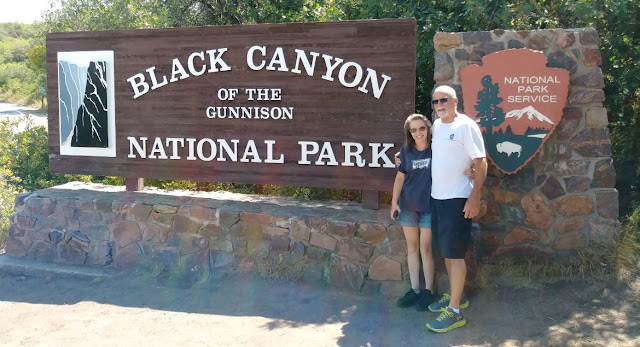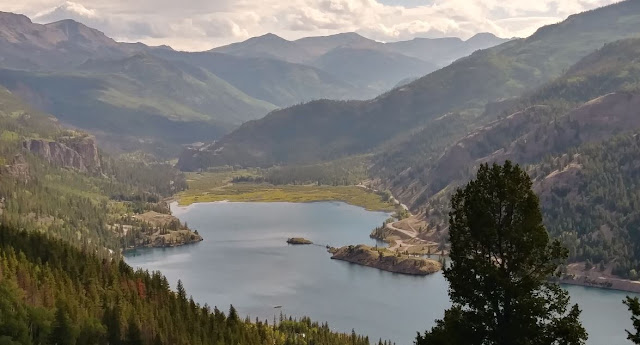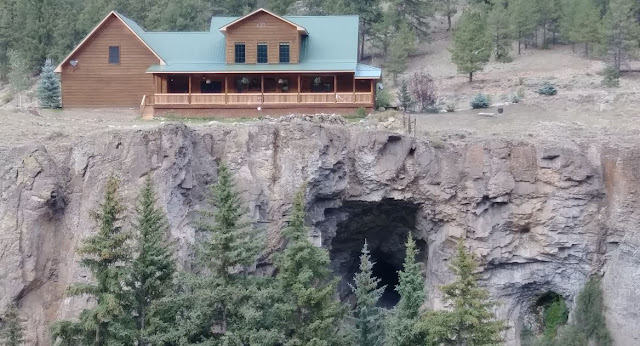At the first scenic overlook, Tomichi Point, we stopped and snapped a group selfie. LtoR: Jim, Michelle, Gari & Steve
A view from Tomichi Point
Gari and Steve at Tomichi Point
Another excited group at Tomichi Point. The views at this first stop certainly had us all mesmerized. While the Grand Canyon is much larger than The Black Canyon, it is the smaller size of the Black Canyon that makes the views more intimate and seemingly much closer to the observer. The Grand Canyon is 277 miles long and up to 18 miles wide, while the Black Canyon is only 48 miles long and just 14 miles long within the National Park, and at it's narrowest is a mere 40 ft wide! The Grand Canyon is over 6,000 ft deep is places, while the Black Canyon is much less at just over 2,700 ft deep, but believe me that is still a looooong way down!
The length of the Upper Black Canyon that we visited this day was about 6.5 miles long. The views were spectacular all day long.
From Tomichi Point we proceeded to the Black Canyon Visitor's Center a short distance away. Michelle and Jim capture a commemorative photo at the park entrance sign.
The Visitor's Center is perched on the edge of the canyon and has it's own spectacular views. We could see the observation area on Gunnison Point from the Visitor's Center.
We moved on to the Gunnison Overlook and had a nice view back to the Visitor's Center building,
Gari leads the way down to the overlook.
Here comes the rest of the crew.
Another friendly visitor offered to photograph our whole group.
Gari slowly and carefully approaches the edge for a look into the canyon.
Steve and Gari get a hero shot at the overlook.
Michelle and Jim find a comfortable seat with a spectacular view!
Down the road we stop at the Painted Wall which is Colorado's highest cliff at 2,250 ft. Jim and Michelle get a nice shot where we can see the river below.
The Painted Wall in all it's magnificence!
At this stop there was a Park Ranger preparing to give a talk. We asked about the rapids in the canyon. She was a native of the area and informed us that not only were there Class VI rapids, the largest classified rapids, but there were also some "Unclassified" rapids. We were informed that "Unclassified" meant larger than Class VI!
Besties, Gari & Michelle, at the next overlook.
At this stop we witnessed some insanity of youth... There are pieces of that puzzle in the shot below. You can see a young girl near Gari at the overlook. Look closely and you can see Jim in the foreground peeking over a rock. To the right of Jim you will see the second young girl, they were friends visiting from Baltimore. The girl near Jim is taking pictures with her nice SLR camera.
This is the insanity! The young girl with the SLR camera decided it would be a good idea to go around the railing and climb out on an unprotected ledge high up on the canyon wall! Absolute insanity of youth! It was hard to watch that. One big breeze or slight misstep would be all that it would take to make this stunt end in disaster.
Steve documents the last stop, which is a 3/4 mile hike to the overlook. It is named after the Presbyterian Preacher who used to love to come out to this point and commune with the beautiful and peaceful creation found there.
We could see back to the Painted Wall from the Warner Point Trail.
Another spectacular view from Warner Trail.
Michelle gets a hero shot in front of the magnificent canyon view.
One of the things that Warner enjoyed were the Pinion Pines; this may be one that he admired. We sure did.
Jim and Michelle at Warner Point overlook.
Gari scanning the canyon below at Warner Point.
Of course the Chipmunks were plentiful up there.
Looking back up Black Canyon from Warner Point.
One parting shot of the Lower Black Canyon.




































































